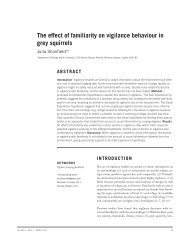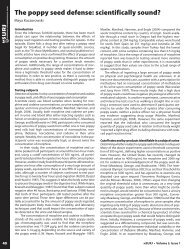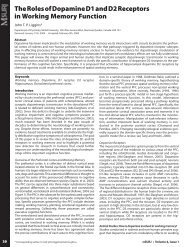the entire issue - McGill Science Undergraduate Research Journal ...
the entire issue - McGill Science Undergraduate Research Journal ...
the entire issue - McGill Science Undergraduate Research Journal ...
Create successful ePaper yourself
Turn your PDF publications into a flip-book with our unique Google optimized e-Paper software.
HM: A Legacy in Neuroscience<br />
Eric Eckbo<br />
Department of Psychology, <strong>McGill</strong> University, Stewart Biology Building, 1205 Dr. Penfield Avenue, Montreal, Quebec, Canada, H3A 1B1<br />
Article submitted: January 4, 2009 - Article accepted: February 5, 2009<br />
“The problem of neurology is to understand man himself.”<br />
Walking by <strong>the</strong> Montreal Neurological Institute (MNI)<br />
and Hospital, one might give brief regard to <strong>the</strong>se words<br />
coined by Wilder Penfield and prominently displayed on <strong>the</strong><br />
edifice of <strong>the</strong> building. It is unlikely, however, that most passersby<br />
would have an accurate grasp of <strong>the</strong> groundbreaking<br />
work that has been undertaken by scientists at this institute<br />
– research that has delved into <strong>the</strong> inner workings of <strong>the</strong> human<br />
mind. During <strong>the</strong> 1930s, Penfield developed <strong>the</strong> surgical<br />
treatment of epilepsy by means of temporal lobe resection,<br />
and this procedure became a standard among many neurosurgical<br />
centres (Greenblatt, Dagi, et al. 1997). The MNI is also<br />
where Brenda Milner began her groundbreaking work in <strong>the</strong><br />
field of neuropsychology, most notably with a patient who<br />
until recently was simply known as HM.<br />
Nowadays, it is a rare occurrence that one can attribute<br />
significant advances in science to a single individual, especially<br />
one with no post-secondary education or formal training.<br />
However, no neuroscience textbook would be complete<br />
without mention of HM, a patient suffering from severe nonlocalized<br />
epilepsy and perhaps <strong>the</strong> most studied individual in<br />
<strong>the</strong> field (Corkin, 1984). H.M. was born in 1926, and at <strong>the</strong> age<br />
of 7 was involved in a bicycle accident that left him unconscious<br />
for 5 minutes. In addition, he suffered a laceration to<br />
<strong>the</strong> left supra-orbital region of his head (Corkin, 1984). At <strong>the</strong><br />
age of 10, HM began exhibiting minor seizures, during which<br />
he would cross his arms and legs, open his mouth, close his<br />
eyes, and generally exhibit a lack of responsiveness. By <strong>the</strong><br />
time he was 16, <strong>the</strong> seizures had progressed to major attacks.<br />
These general convulsions included tongue-biting, urinary<br />
incontinence, loss of consciousness, and ensuing drowsiness<br />
(Scoville and Milner, 1957). It is believed that <strong>the</strong> bicycle incident<br />
was linked to <strong>the</strong> onset of epilepsy, though <strong>the</strong> basic<br />
radiological studies and physical examinations available at<br />
<strong>the</strong> time showed normal findings (Scoville and Milner, 1957).<br />
This may, however, have only been a reflection of <strong>the</strong> state<br />
of imaging technology at <strong>the</strong> time and it is unclear whe<strong>the</strong>r<br />
modern neuroimaging techniques would have identified<br />
abnormalities. HM’s family history shows a presence of epilepsy,<br />
which may be indicative of an unrelated causative factor<br />
(Corkin, 2002). None<strong>the</strong>less, <strong>the</strong> etiology of HM’s disorder<br />
still remains inconclusive.<br />
In 1953, at <strong>the</strong> age of 27, HM underwent an experimental<br />
procedure in order to alleviate <strong>the</strong> severe epilepsy that<br />
had remained largely unresponsive to anticonvulsive drug<br />
<strong>the</strong>rapy. At this point, he was having 10 petit mal seizures a<br />
day and at least 1 major seizure per week (Corkin, 1984). Electroencephalographic<br />
recordings indicated diffuse abnormalities;<br />
hence, <strong>the</strong> decision was made to surgically remove <strong>the</strong><br />
medial temporal lobe structures, which were known to have<br />
epileptogenic qualities (Scoville and Milner, 1957). The bilateral<br />
medial temporal lobe resection extended 8cm posteriorly<br />
from <strong>the</strong> temporal tip, including <strong>the</strong> amygdaloid complex,<br />
temporal pole, and a large part of <strong>the</strong> hippocampal formation<br />
(Scoville and Milner, 1957). During <strong>the</strong> surgery, HM was fully<br />
conscious and talking (Corkin, 1984). The surgery succeeded<br />
in abating <strong>the</strong> severity of HM’s seizures and he recovered<br />
from <strong>the</strong> surgery without any complications. However, <strong>the</strong>re<br />
was one completely unexpected side effect of <strong>the</strong> surgery:<br />
severe anterograde amnesia, characterized by a loss of ability<br />
to formulate new memories (Scoville and Milner, 1957).<br />
The beginning of <strong>the</strong> nineteenth century marked <strong>the</strong> onset<br />
of <strong>the</strong> memory debate in <strong>the</strong> neuroscience community.<br />
Specifically, scientists began to question where memory is stored<br />
and <strong>the</strong> extent of its localization in <strong>the</strong> brain (Greenblatt,<br />
Dagi, et al. 1997). In <strong>the</strong> early half of <strong>the</strong> twentieth century,<br />
Karl Lashley, a prominent neuropsychologist, conducted studies<br />
in rats that led to his <strong>the</strong>ory of mass action. Removal of<br />
cortical areas of rat brains did not show any evidence of memory<br />
storage localization, but ra<strong>the</strong>r demonstrated that <strong>the</strong><br />
extent of memory deficit is proportional to <strong>the</strong> amount of cortical<br />
t<strong>issue</strong> removed (Greenblatt, Dagi, et al. 1997). Opponents<br />
of this <strong>the</strong>ory, notably Donald Hebb, proposed an alternate<br />
view. Hebb <strong>the</strong>orized that “assemblies” of cells work toge<strong>the</strong>r<br />
to represent information and that <strong>the</strong>se complexes are widely<br />
distributed. In <strong>the</strong> event of a localized lesion, <strong>the</strong> distributional<br />
nature and significant number of interconnected cells would<br />
ensure continued functioning (Milner, Squire, et al. 1998).<br />
After performing <strong>the</strong> procedure on H.M. and recognizing<br />
<strong>the</strong> unexpected amnesic syndrome, William Scoville invited<br />
Brenda Milner to Connecticut to systematically evaluate HM’s<br />
condition using neuropsychological methods. In 1957, Milner<br />
and Scoville published what would soon become a groundbreaking<br />
paper on memory. The surgeon and neuropsychologist<br />
described <strong>the</strong> results of testing of HM and nine o<strong>the</strong>r<br />
patients, who had been treated for psychosis using neurosurgical<br />
methods similar to those performed on HM (Scoville and<br />
Milner, 1957). HM was a unique case to consider since he did<br />
not suffer from psychosis, and his surgery was “frankly experimental”<br />
(Scoville and Milner, 1957). At <strong>the</strong> onset of extensive<br />
testing in 1955, memory deficits were immediately apparent<br />
– HM gave <strong>the</strong> date as March 1953 and his age as 27 (Scoville<br />
and Milner, 1957). Milner and Scoville (1957) also noted that<br />
“he reverted constantly to boyhood events and seemed scarcely<br />
to realize that he had had an operation.” HM’s IQ on <strong>the</strong><br />
Wechsler-Bellevue Intelligence Scale actually improved from a<br />
preoperative score of 104 to a postoperative 112 due to <strong>the</strong> reduction<br />
in seizures (Scoville and Milner, 1957). In contrast, his<br />
score was determined to be 67 on <strong>the</strong> Wechsler Memory Scale,<br />
far below average for someone of his intellectual capacity (Scoville<br />
and Milner, 1957). A battery of tests confirmed Milner’s<br />
suspicions: HM suffered from a complete loss of memory for<br />
all events occurring after <strong>the</strong> surgery, and a partial retrograde<br />
amnesia for three years preceding <strong>the</strong> surgery (Milner, Corkin,<br />
et al. 1968). Studies performed later in 1985 showed that this<br />
retrograde amnesia extended to include a period of 11 years<br />
prior to surgery (Corkin, 2002). Memories of his early life events<br />
and his pre-surgical personality remained unaffected.<br />
Fur<strong>the</strong>r testing also demonstrated <strong>the</strong> pervasiveness of<br />
HM’s memory disorder. He was severely impaired regardless<br />
of <strong>the</strong> type of memory test, <strong>the</strong> nature of <strong>the</strong> stimulus, or <strong>the</strong><br />
sensory modality through which <strong>the</strong> test was delivered (Milner,<br />
Corkin, et al. 1968; Corkin, 2002). He was unable to successfully<br />
acquire long-term episodic memory (events in a spatial/<br />
time context) or semantic memory (general knowledge and<br />
factual information); however, he had functional short-term<br />
memory (Milner, Corkin, et al. 1968; Corkin, 2002). HM was<br />
readily able to register new information within his immediate<br />
March 2009 • msurj.mcgill.ca 9









